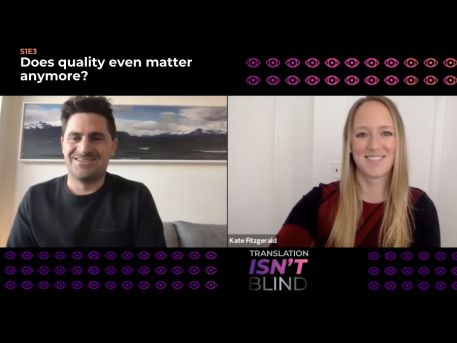Translation Isn't Blind: Does quality even matter anymore? from Smartling on Vimeo.
Jump straight to the good stuff:
- 0:17 - Adrian’s quarantine haircut mishap
- 4:31 - Translators Without Borders fundraising
- 5:31 - FREE e-book The Ultimate Guide to Maximizing Your Translation Value:
- 7:35 - Jump into the meat and potatoes
- 15:57 - Considerations for determining the quality of content
- 17:00 - Important questions to ask yourself about content quality
- 17:50 - Communicating with the source content creator
- 20:09 - How teams with localization work with content creators
- 25:23 - How Kate thinks the 80/20 rule applies to data-driven approach
- 25:42 - Examples of data driven quality assessments:Global delivery network gives us insight to data that can help inform decisions
- 33:42 - Spaces outside of Smartling to derive stats and analytics
- 35:09 - How Smartling can help keep quality high and cost low
- 35:30 - Dynamic workflows
- 40:20 - Data allows you to make smart choices
- 42:05 - Examples of increased revenue because of improved translation quality
- 46:43 - Content segmentation and Kate’s criteria philosophies
Quality Lies in the Eye of the Beholder: But Does Quality Matter Anymore?
We all want our projects to kick off as easily as possible and without drama. While there are ways to implement steps to ensure we are taking the best route towards success when translating our content, it is always ideal to take a step back to consider what is worth the time and effort and what can be placed temporarily on the back burner.
We all agree quality of content is very important. We want our messages to resonate across the board and evoke meaning to our audience. As we covered in our discussion around internal review, the workflow you choose to implement should depend on how much time you put into creating the content of origin. And quality is no different!
When we think of the quality of our content it’s important to remember one thing: every person sees the world differently. We all have an individual and unique perspective that shapes how we see, understand, and absorb content.
Not all content is created equally.
Here are some questions to help you determine if your translated content is an ideal candidate for quality assurance when translating:
How much time and attention did you put into your source content? What resources and budget were put into your project? How source content was first developed and what is it meant to do? Where is the density for it to live once published?
“Some say translation quality is paramount, while others may say speed is more important. It depends completely on your initiatives.”
Evaluating the content you’re working with: data versus criteria.
We all want to deliver the best possible experiences and work to our end users.
To do that we must invest in linguistic assets to help ensure resources are being allocated responsibly. If your source content is great (also subjective; see how hard this can be?) we can branch our approach into two different paths to achieve a balance of cost and value:
- Data-driven approaches include considering what the most important metrics are to your mission and how they drive business.
Do you value:
- Website views
- Product selection / popularity
- Revenue impact
- Addressable market
- TM leverage
Sit back and think: “Where does the bulk of my revenue come from" to better understand where your team can place the most value.
- Criteria-based approaches is comprised of:
- Is the mission critical?
- Source content value
- Ownership and delivery
- Measurability
The criteria-based route includes any and all legal content, the main pillars of this approach include safety and life/death potential outcomes of copy being inaccurate, considering the technical impact on a business and revenue impact.
Sit back and think: “What was my source content intended to do? What was it’s destiny?”
Some end goals for you to consider include:
- Connection between translation and business outcome.
- Create competitive advantage.
- Get to market faster.
- Ability to reduce the number of people working on a project.
- ROI and less spend on projects.
Still unsure as to what to do? Smartling can help.
Smartling can boster your data driven analytics by accessing niche data to help make informed choices with our Global Ready Network.
If you’re interested in a cost-effective, cloud-based option that can help you eliminate the need to internationalize code, build site replicas and source global network servers for long-distance content delivery, book a meeting with our team!
Translation Isn't Blind
We're bringing translation into focus during our new mini webinar series, Translation Isn't Blind. There’s an ongoing appetite to debate the value of internally reviewing translation. Do you kill it, or optimize it? During this episode, we dive into how you can optimize your process so that you can do a little bit of both.
Translation Isn't Blind has more in store! Check out our previous and upcoming episodes below. 👇
S1 E1: Navigating Global Crises
During the season premiere episode, Kate Fitzgerald and Adrian Cohn covered the tools and resources you need to respond to crises and evolving situations as the world responds to COVID-19. View the recording here.
S1 E2: Internal Review: Kill it or optimize?
We'll cover the in's and out's of internally reviewing translation: an “insurance policy” that is designed to minimize a company’s exposure to publishing low quality - or unacceptable - translations. So, what should you do: kill it, or optimize internal review? Yes, you can - you can do one, or the other, or a little bit of both. View the recording here.
S1 E4: Your perspective matters.
Like all things in life, perspective prevails. Every business takes a different approach to manage translation quality, so why not take a closer look at what it means in the context of specific businesses? Let’s bring quality into focus: share your translation quality success stories or flops and we’ll discuss the themes behind each success and learning moment.
S1 E5: We translate because...
Conventional wisdom tells us that translation expands reach; and reach drives revenue. But what about unconventional wisdom - the out-of-the-box reasons for translating? As Dr. Stephen Covey says, “Seek first to understand, then to be understood.” Reframe how you talk about translation internally through untold stories about why other businesses translate.
S1 E6: Help me convince my manager
“Translation” lives in different places from one company to the next. Sometimes it’s managed by localization teams, and other times it’s managed by the product team. No matter how your organization decides who owns translation, it’s important that you reveal to your manager how and why translation adds value to the business - how translation isn’t blind.
About Laura
Laura Wyant is a freelance digital strategist and writer/editor. She is currently working with start-ups, tech companies, and health and healing spaces. Laura has been contributing to the Smartling blog on topics around cloud translation, digital strategy, and overall creative translation process. When she isn’t working in media, she is working to educate herself on matters such as intersectional women’s health and advancements in technology.







